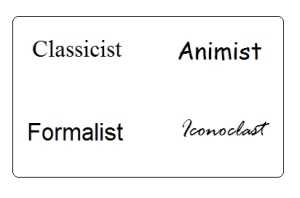Scott McCloud: The visual magic of comics
It’s a new year!
In 2013 there were approximately half as many EdTalksTed posts (in comparison to 2012) but overall traffic more than doubled, thus leading me to believe that if I posted only once this year it’ll go viral.
(I don’t think so.)
Much to my surprise, 2013 also included the first time some Ted speakers took the time to contact me and thank me for carrying on their conversation. (Even when I’m making butt jokes.)
Scott has a remarkable opening about family and expectations that drew me in quicker than most speakers, not only was it an interesting diversion from the expected topic but it also showed a great deal of his persona on stage. The individual who he was trying to convey included one not only of being part of a comic artist but being part of a family that he felt was larger than he was.
In any case, here’s the talk.
Total views to date: 645,220
Total Time: 17 minutes, 6 seconds
Posted: Jan 2009
It doesn’t very long to realize that not only is McCloud very well spoken but in a case similar to most when trying to convey a complicated meaning, he needs to be a bit long winded. (This also a reminder of when I started with 7,500 word blog posts)
Now McCloud brings up several beautiful patterns that he identifies, the evolution of how we came to digest the medium in its current form and his own philosophical hopes of how the digital age can embrace comics as an artistic expression. Considering it’s all done in a whirlwind of images and jokes, let’s see if we can break it down.
McCloud’s three types of vision, where each classification excludes the other.
(Try not to go too blind with the terrible visuals)
To McCloud’s four types of comics (All of which can overlap each other)
Why am I including these terribly made MS Paint images? One, to show that I wish this computer had better applications, even maybe MSOffice (a spreadsheet in Excel would have looked better) and two, that even subtle changes like ‘font’ can create classifications in an immediate identifiable manner (just look at them!). McCloud makes his point in that not only does art style show the flavor of the message but as he noted via McLuhan, the medium actually conveys a message in itself.
“The medium is the message.” – McCluhan
McCloud also briefly mentions Jung’s four psychological functions as another parallel but doesn’t describe it. So I’ll try to briefly list them here:
Jung’s Four Psychological functions is Jung’s description of how humans become capable of conscious, and subsequently acquire knowledge (of themselves and the world). These four functions are Intuition, Sensation, Feeling and Thinking.
Intuition – perception of unconscious events
Sensation – perception by the five senses
Feeling – subjective evaluation
Thinking – function of intellectual cognition
There literally are 36 hour long lectures out there which cover this topic so its quite unfeasible to explain it all, which might be why he just dropped it and moved on.
Long story short, French philosophical seagull says, “Pourquoi?”
Frankly, I don’t think seagulls sound like that. They more go “EEEK EEK CAWW CAWW” which isn’t very helpful.. to anything.
McCloud then goes into how the monitor if used as a window, allows impossible art, or the ability to ‘circle again’ and show the comic medium on how it was originally presented in one long scrolling tapestry.
As an individual who still reads the odd comic book only through the digital medium, I can easily state that isn’t the norm. There still exists costs (time/money/work) involved which make the efforts required to not balance with the outcome. (eg> how much MORE money it would earn by having it)
On the other hand, there are more that have tried to explore the medium.
XKCD had created a comic entitled ‘Time’, where it was posted online and periodically the image was updated to a slightly altered image, creating a slow movie of sorts that expanded well beyond a normal comic post. (linked below is a player that will run through all 3099 images)
http://geekwagon.net/projects/xkcd1190/
XKCD”s Click and Drag: (an example of the ‘endless canvass’)
The Order of the Stick’s #443, where one of the hero’s falls to his death in an ‘impossible to print’ column that scrolls downward.
http://www.giantitp.com/comics/oots0443.html
(Inadvertently, this phenomenon also occurs on the webcomic Weekend Pass (www.weekendpass.net), where the characters slowly move across a huge background, but that is an afterthought that isn’t near as impacting as the examples above)
Now it isn’t that ‘standard’ comics haven’t tried to change their delivery. The explosion of smart phones now occupying the market has forced comics to enter an ‘altered state’ in order for their content to be consumed by the handheld.
Apps such as ComiXology provide not only a means to purchase comics from your phone, but it also doubles as a reader where you can read the comic with pre-defined scrolling with magnifications so one can read the comic with simple swipes.
Videogames, have done something similar as well in designer’s attempts to constantly create original content. This past year showed one of the most innovative games, Device6, a book / puzzle game which is read along all four sides of a handheld that has already won IGN’s Game of the Year (2013) on iOS.
McCloud’s final take away is that whenever we re-observe our world in a different ‘window’, we gain a new understanding of our own world.
This is a statement that has never been more true.

Earthrise (Image credit: NASA)
Explore and share,
ED

